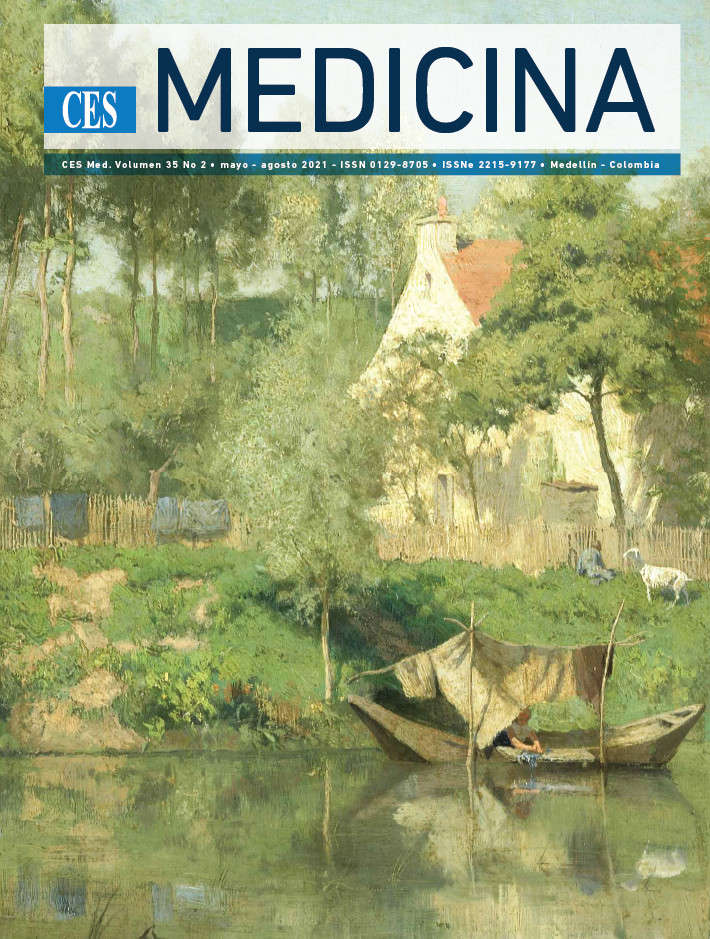Micobioma: diversidad fúngica en el cuerpo humano
DOI:
https://doi.org/10.21615/cesmedicina.5686Palabras clave:
Micobioma, Microbioma fúngico, Disbiosis, SaludResumen
Introducción: los hongos hacen parte de los microorganismos que se encuentran en el ser humano y que interactúan con bacterias, virus y archaeas. El equilibrio inter e intra-especies es importante para mantener la salud en los seres humanos. La mayoría de los estudios sobre la micobioma se han relacionado con estados de enfermedad causados por hongos, siendo de relevancia la exploración de las comunidades comensales en individuos sanos. Métodos: se realizó una búsqueda bibliográfica en PubMed, ScienceDirect, Scopus y Google Scholar, usando los términos mycobiome, intestinal fungi, skin mycobiome, vaginal mycobiome, fungal microbiome. Se incluyeron artículos desde 1996 hasta 2020, de revisión y de resultados de investigación en todos los idiomas. Resultados y discusión: existe variabilidad en las comunidades fúngicas en los sitios corporales según sus características intrínsecas y la relación con el medio ambiente. El estado de salud en los seres humanos puede estar influenciado por la densidad y diversidad fúngica, a diferencia de los individuos enfermos en quienes se evidencia una disminución en la diversidad y que se asocia con el oportunismo de agentes patógenos.
Descargas
Referencias bibliográficas
CDC. Fungal Infections - Protect Your Health [Internet]. Fungal Diseases. 2019 [cited 2019 Sep 27]. Available from: https://www.cdc.gov/fungal/features/fungal-infections.html
Ward TL, Knights D, Gale CA. Infant fungal communities: current knowledge and research opportunities. BMC Med [Internet]. 2017 [cited 2019 Sep 9];15(1):30. Available from: http://bmcmedicine.biomedcentral.com/articles/10.1186/s12916-017-0802-z
Collado MC, Rautava S, Aakko J, Isolauri E, Salminen S. Human gut colonisation may be initiated in utero by distinct microbial communities in the placenta and amniotic fluid. Sci Rep [Internet]. 2016 [cited 2019 Sep 10];6(1):23129. Available from: http://www.nature.com/articles/srep23129
Schei K, Avershina E, Øien T, Rudi K, Follestad T, Salamati S, et al. Early gut mycobiota and mother-offspring transfer. Microbiome [Internet]. 2017 [cited 2019 Sep 9];5(1):107. Available from: http://www.ncbi.nlm.nih.gov/pubmed/28837002
Boix-Amorós A, Puente-Sánchez F, du Toit E, Linderborg KM, Zhang Y, Yang B, et al. Mycobiome Profiles in breast milk from healthy women depend on mode of delivery, geographic location, and interaction with Bacteria. Druzhinina IS, editor. Appl Environ Microbiol [Internet]. 2019 [cited 2019 Sep 9];85(9). Available from: http://www.ncbi.nlm.nih.gov/pubmed/30824446
Lemoinne S, Kemgang A, Ben Belkacem K, Straube M, Jegou S, Corpechot C, et al. Fungi participate in the dysbiosis of gut microbiota in patients with primary sclerosing cholangitis. Gut [Internet]. 2020 [cited 2019 Sep 9];69(1):92–102. Available from: http://www.ncbi.nlm.nih.gov/pubmed/31003979
Hallen-Adams HE, Suhr MJ. Fungi in the healthy human gastrointestinal tract. Virulence [Internet]. 2017 [cited 2019 Sep 9];8(3):352–8. Available from: https://www.tandfonline.com/doi/full/10.1080/21505594.2016.1247140
Nash AK, Auchtung TA, Wong MC, Smith DP, Gesell JR, Ross MC, et al. The gut mycobiome of the human microbiome project healthy cohort. Microbiome [Internet]. 2017 [cited 2019 Sep 8];5(1):153. Available from: https://microbiomejournal.biomedcentral.com/articles/10.1186/s40168-017-0373-4
Jayasudha R, Kalyana Chakravarthy S, Sai Prashanthi G, Sharma S, Tyagi M, Shivaji S. Implicating dysbiosis of the gut fungal microbiome in uveitis, an inflammatory disease of the eye. Investig Opthalmology Vis Sci. 2019;60(5):1384–93.
Hoffmann C, Dollive S, Grunberg S, Chen J, Li H, Wu GD, et al. Archaea and Fungi of the Human Gut Microbiome: Correlations with diet and bacterial residents. Pan C, editor. PLoS One. 2013;8(6):e66019.
Sellart-Altisent M, Torres-Rodríguez JM, Gómez de Ana S, Alvarado-Ramírez E. Microbiota fúngica nasal en sujetos alérgicos y sanos. Rev Iberoam Micol. 2007;24(2):125–30.
Rickerts V. Klimawandel und Epidemiologie systemischer Pilzinfektionen. Bundesgesundheitsbl [Internet]. 2019 [cited 2019 Sep 18];62(5):646–51. Available from: http://link.springer.com/10.1007/s00103-019-02931-z
Yan D, Zhang T, Su J, Zhao L-L, Wang H, Fang X-M, et al. Structural variation in the bacterial community associated with airborne particulate matter in Beijing, China, during Hazy and Nonhazy Days. Schaffner DW, editor. Appl Environ Microbiol [Internet]. 2018 [cited 2019 Sep 5];84(9). Available from: https://journals.asm.org/doi/10.1128/AEM.00004-18
Liu P-Y, Tsan Y-T, Chan Y-W, Chan W-C, Shi Z-Y, Yang C-T, et al. Associations of PM2.5 and aspergillosis: ambient fine particulate air pollution and population-based big data linkage analyses. J Ambient Intell Humaniz Comput [Internet]. 2018 [cited 2019 Sep 19];1–11. Available from: http://link.springer.com/10.1007/s12652-018-0852-x
Zhang I, Pletcher SD, Goldberg AN, Barker BM, Cope EK. Fungal microbiota in chronic airway inflammatory disease and emerging relationships with the host immune response. Front Microbiol. 2017;8(2477):1–7.
Zhao YC, Bassiouni A, Tanjararak K, Vreugde S, Wormald P-J, Psaltis AJ. Role of fungi in chronic rhinosinusitis through ITS sequencing. Laryngoscope [Internet]. 2018 [cited 2019 Sep 18];128(1):16–22. Available from: http://www.ncbi.nlm.nih.gov/pubmed/28675446
Gelber JT, Cope EK, Goldberg AN, Pletcher SD. Evaluation of Malassezia and Common fungal pathogens in subtypes of chronic rhinosinusitis. Int Forum Allergy Rhinol [Internet]. 2016 [cited 2019 Sep 18];6(9):950–5. Available from: http://www.ncbi.nlm.nih.gov/pubmed/27153455
Kim J, Kim H. Microbiome of the Skin and Gut in Atopic Dermatitis (AD): Understanding the Pathophysiology and Finding Novel Management Strategies. J Clin Med [Internet]. 2019 [cited 2019 Sep 27];8(4):444. Available from: https://www.mdpi.com/2077-0383/8/4/444
Mok WY, Barreto da Silva MS. Mycoflora of the human dermal surfaces. Can J Microbiol [Internet]. 1984 [cited 2019 Sep 27];30(10):1205–9. Available from: http://www.ncbi.nlm.nih.gov/pubmed/6509388
Jo J-H, Kennedy EA, Kong HH. Topographical and physiological differences of the skin mycobiome in health and disease. Virulence [Internet]. 2017 [cited 2019 Sep 27];8(3):324–33. Available from: https://www.tandfonline.com/doi/full/10.1080/21505594.2016.1249093
Sugita T, Suto H, Unno T, Tsuboi R, Ogawa H, Shinoda T, et al. Molecular Analysis of Malassezia Microflora on the Skin of Atopic Dermatitis Patients and Healthy Subjects. J Clin Microbiol [Internet]. 2001 Oct 1 [cited 2019 Sep 27];39(10):3486–90. Available from: http://jcm.asm.org/cgi/doi/10.1128/JCM.39.10.3486-3490.2001
Paulino LC, Tseng CH, Strober BE, Blaser MJ. Molecular analysis of fungal microbiota in samples from healthy human skin and psoriatic lesions. J Clin Microbiol. 2006;44(8):2933–41.
Zhang E, Tanaka T, Tajima M, Tsuboi R, Nishikawa A, Sugita T. Characterization of the skin fungal microbiota in patients with atopic dermatitis and in healthy subjects. Microbiol Immunol [Internet]. 2011 [cited 2019 Sep 27];55(9):625–32. Available from: http://doi.wiley.com/10.1111/j.1348-0421.2011.00364.x
Jo J-H, Deming C, Kennedy EA, Conlan S, Polley EC, Ng W-I, et al. Diverse human skin fungal communities in children converge in adulthood. J Invest Dermatol [Internet]. 2016 [cited 2019 Sep 27];136(12):2356–63. Available from: http://www.ncbi.nlm.nih.gov/pubmed/27476723
Enoz M, Sevinc I, Lapeña JF. Bacterial and fungal organisms in otitis externa patients without fungal infection risk factors in Erzurum, Turkey. Braz J Otorhinolaryngol [Internet]. 2009 [cited 2019 Sep 21];75(5):721–5. Available from: http://www.scielo.br/scielo.php?script=sci_arttext&pid=S1808-86942009000500018&lng=en&nrm=iso&tlng=en
Kaneko T, Shiota R, Shibuya S, Watanabe S, Umeda Y, Takeshita K, et al. Human external ear canal as the specific reservoir of Malassezia slooffiae. Med Mycol. 2010;48(6):824–7.
Ruslan RE, Rajagopalan R, Ng K. Fungi in the normal human external ear. Indian J Otol [Internet]. 2019 [cited 2019 Sep 21];25(2):76. Available from: http://www.indianjotol.org/text.asp?2019/25/2/76/264677
Wang Y, Chen H, Xia T, Huang Y. Characterization of fungal microbiota on normal ocular surface of humans. Clin Microbiol Infect [Internet]. 2020 [cited 2019 Sep 27];26(1):123.e9-123.e13. Available from: https://linkinghub.elsevier.com/retrieve/pii/S1198743X19302265
Ghannoum MA, Jurevic RJ, Mukherjee PK, Cui F, Sikaroodi M, Naqvi A, et al. Characterization of the oral fungal microbiome (mycobiome) in healthy Individuals. May RC, editor. PLoS Pathog [Internet]. 2010 [cited 2019 Sep 19];6(1):e1000713. Available from: https://dx.plos.org/10.1371/journal.ppat.1000713
Diaz PI, Hong B-Y, Dupuy AK, Strausbaugh LD. Mining the oral mycobiome: Methods, components, and meaning. Virulence. 2017;8(3):313–23.
Peters BA, Wu J, Hayes RB, Ahn J. The oral fungal mycobiome: characteristics and relation to periodontitis in a pilot study. BMC Microbiol [Internet]. 2017 [cited 2019 Sep 21];17(1):157. Available from: http://www.ncbi.nlm.nih.gov/pubmed/28701186
Bliss JM, Basavegowda KP, Watson WJ, Sheikh AU, Ryan RM. Vertical and horizontal transmission of Candida albicans in very low birth weight infants using DNA fingerprinting techniques. Pediatr Infect Dis J [Internet]. 2008 [cited 2019 Sep 10];27(3):231–5. Available from: http://www.ncbi.nlm.nih.gov/pubmed/18277930
Sobel JD. Vulvovaginal candidosis. Lancet (London, England) [Internet]. 2007 [cited 2019 Sep 27];369(9577):1961–71. Available from: http://www.ncbi.nlm.nih.gov/pubmed/17560449
Monteiro-da-Silva F, Araujo R, Sampaio-Maia B. Interindividual variability and intraindividual stability of oral fungal microbiota over time. Med Mycol [Internet]. 2014 [cited 2019 Sep 21];52(5):498–505. Available from: http://www.ncbi.nlm.nih.gov/pubmed/24934804
Descargas
Publicado
Cómo citar
Número
Sección
Licencia
Derechos de autor 2021 CES Medicina

Esta obra está bajo una licencia internacional Creative Commons Atribución-NoComercial-CompartirIgual 4.0.
Derechos de reproducción (copyright)
Cada manuscrito se acompañará de una declaración en la que se especifique que los materiales son inéditos, que no han sido publicados anteriormente en formato impreso o electrónico y que no se presentarán a ningún otro medio antes de conocer la decisión de la revista. En todo caso, cualquier publicación anterior, sea en forma impresa o electrónica, deberá darse a conocer a la redacción por escrito.
Plagios, duplicaciones totales o parciales, traduccones del original a otro idioma son de responsabilidad exclusiva de los autores el envío.
Los autores adjuntarán una declaración firmada indicando que, si el manuscrito se acepta para su publicación, los derechos de reproducción son propiedad exclusiva de la Revista CES Medicina.
Se solicita a los autores que proporcionen la información completa acerca de cualquier beca o subvención recibida de una entidad comercial u otro grupo con intereses privados, u otro organismo, para costear parcial o totalmente el trabajo en que se basa el artículo.
Los autores tienen la responsabilidad de obtener los permisos necesarios para reproducir cualquier material protegido por derechos de reproducción. El manuscrito se acompañará de la carta original que otorgue ese permiso y en ella debe especificarse con exactitud el número del cuadro o figura o el texto exacto que se citará y cómo se usará, así como la referencia bibliográfica completa.
| Estadísticas de artículo | |
|---|---|
| Vistas de resúmenes | |
| Vistas de PDF | |
| Descargas de PDF | |
| Vistas de HTML | |
| Otras vistas | |



